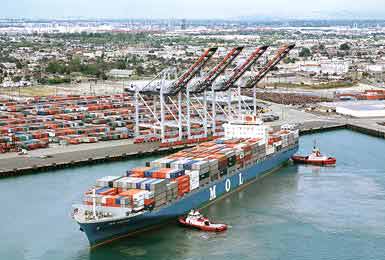New Technology Designed to Protect U.S. Seaports
April 2012

Security actually begins hundreds or thousands of miles away from American coasts with the Container Security Initiative (CSI). U.S. Customs and Border Protection agents work with their foreign counterparts to conduct inspections of high-risk cargo containers worldwide at approximately 40 foreign seaports. Inspection occurs before the containers are loaded onto ships bound for the United States.
Deploying Technology
To speed deployment of technology, whenever possible, it is adapted from other uses. For example, video-equipped submersibles - essentially underwater robots - are used to detect threats under harbor waters, such as explosives attached to ship hulls. These submersibles have been adapted from submersibles developed for other uses, such as ocean fish farming and marine biology research.
The primary need is for methods to rapidly inspect cargo containers for illegal or hazardous contents. The DHS Transportation Security Laboratory (TSL) in Atlantic City, N.J., is focused on meeting this need. Its Container Security Test Bed (CSTB) is an outdoor laboratory allowing researchers from government, academia, and industry to develop ways to detect threats by analyzing the air inside cargo containers. The CSTB handles the containers the same way they would be offloaded from a ship.
The CSTB uses sensors such as gas chromatographs and mass spectrometers originally developed for chemical and pharmaceutical manufacturing and for space exploration (such as robot probes that have inspected the surface of Mars). You may have seen carry-on bags being wiped with small swatches of cloth that are then placed into a "black box" for analysis. These sensors can detect trace amounts of explosives, drugs, or other illegal substances. Sensors called Advanced Spectroscopic Portals (ASP) designed to detect radiation can protect seaports from nuclear threats.
Container inspections must be rapid if ports are to operate efficiently. There are two challenges in developing and using these sensors successfully. The first is getting a representative sample of the air from inside the container to the sensor. This can be done through container air vents. This air sample will then pass through a series of sensors for analysis. The results are transmitted to a remote human inspector for review.
To meet the second challenge, the Massachusetts Institute of Technology and Lincoln Labs developed the CSTB to evaluate sensors under real-world conditions, replicating both rapidly screening items in shipping containers and standard ship unloading operations. Sensors must survive the container being hoisted from the ship, moved over, and lowered - often slammed down - onto the pier. Few crane operators have the deft touch that crane operator Tom Cruise did in the movie "War of the Worlds."
According to U.S. Commissioner of Customs Robert Bonner, just one terrorist incident involving shipping containers could shut down global trade. Customs' top priority is counter-terrorism, Bonner says. Results have been worth the effort. The CBP has successfully warded off terrorist threats.
Project Announcements
Southwire Expands Heflin, Alabama, Production Operations
11/17/2025
First Solar Plans Gaffney, South Carolina, Operations
11/15/2025
Ashworth Bros. Upgrades Winchester, Virginia, Production Operations
11/15/2025
Feast & Fettle Plans Elkridge, Maryland, Production-Distribution Operations
11/15/2025
First Quality Retail Services Expands Mifflin County, Pennsylvania, Manufacturing Operations
11/15/2025
Meta Plans Beaver Dam, Wisconsin, Data Center Operations
11/15/2025
Most Read
-
2025’s Top States for Business: How the Winners Are Outpacing the Rest
Q3 2025
-
Rethinking Local Governments Through Consolidation and Choice
Q3 2025
-
The Compliance Reckoning Is Here
Q3 2025
-
Around the Horn: Data Center Supply Chains — What's Next?
Q3 2025
-
First Person: Filter King’s Expansion Playbook
Q3 2025
-
Rethinking Auto Site Strategy in the Age of Tariffs and Powertrain Shifts
Q3 2025
-
Lead with Facts, Land the Deal
Q3 2025



